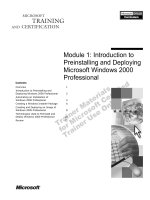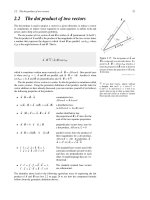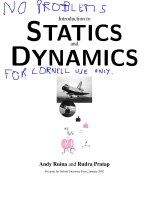Introduction to Portals and Portlets
Bạn đang xem bản rút gọn của tài liệu. Xem và tải ngay bản đầy đủ của tài liệu tại đây (626.77 KB, 10 trang )
1
CHAPTER 1
Introduction to
Portals and Portlets
T
HIS BOOK IS FOR SOFTWARE
developers and designers who develop Java applica-
tions for portals. We cover version 1.0 of the Java portlet API, also known as Java
Specification Request (JSR) 168. Portlets are the individual components that pro-
vide content for a portal. Portals aggregate one or more portlets into web pages,
which are usually personalized or customized for individual users or groups of
users. Some portals also support mobile devices and voice support.
Before the release of this portlet API, each portal had a different API for develop-
ing portlets. Most Java portal vendors will support the JSR 168 standard in addition
to their existing proprietary API. If you develop your portlets to the new portlet API
standard, you can deploy them on any JSR 168-compatible server, just as any com-
patible servlet container can deploy servlets.
You may use the open source portal server Apache Pluto to run the portlets
we write in this book. You are able to deploy your portlets on any other portals
that support the standard, because none of the portlets will use any proprietary
features. We use several open source software components to provide additional
functionality beyond the portlet API.
Some of the problems we provide solutions for in later chapters are person-
alization, portal deployment, Single Sign-On (SSO), content syndication, and the
porting of an existing application into a portal infrastructure. In this chapter, we
discuss portals, information architecture, and background on the portlet API.
Providing a Solution with Portals
Usually, the decision to build a portal environment is made at a high level within
an organization after users become frustrated with using applications that are not
integrated and are not immediately visible. Other times, a project involving an
extranet for suppliers and customers gets started, and the easiest way to aggregate
security for all of these new users is through a portal’s SSO feature. In this book, we
do not discuss the business case for a portal within an organization. We wrote this
book for developers and architects who have chosen to use a portal server that
implements the Java portlet API and need to solve technical problems.
2840ch01.qxd 7/13/04 12:43 PM Page 1
Download at Boykma.Com
Chapter 1
2
From a technical perspective, a portal provides a solution for aggregating con-
tent and applications from various systems for presentation to the end user. The
users do not need to know how the content or functionality is provided; they just
want to enjoy the benefits of a single web site and all of its services. Typically,
a portal has an integrated user interface and an SSO approach for security. The
software developer’s job is to take all of the systems that provide these services and
add interfaces to them to work with the portal. Portlets are the individual compo-
nents displayed in the portal. Prior to the introduction of the standardized portlet
API, portlets had to be custom-developed for each portal server because the API
was different for each server. The leading portal vendors joined to create a standard
to promote portal technology. Inside the Java Community Process (JCP), the name
of the standard for the first version of the Java portlet API is JSR 168. Future versions
of the portlet API will have different JSR numbers.
One of the problems for the designer or architect in charge of the portal proj-
ect is that the existing systems do not always separate cleanly into presentation
and business logic layers. Also, consider portal security and personalization when
examining existing applications. In this book, we port an existing web application
into a portlet application, so you can learn from some of our portlet integration
problems. New software projects that integrate with the portal can use a services-
oriented architecture with exposed web services, a stand-alone web application,
or a portlet.
Portal projects have two major technical components designed in parallel:
application architecture and information architecture. Both of these will flow
from business requirements, and they require an integrated approach. If the por-
tal applications do not support the common information architecture, the users
will have a substandard experience. We discuss creating an information architec-
ture for a portal environment in the next section.
Designing the Portal’s Information Architecture
Moving all of your applications into a portal does not accomplish anything if your
users are not able to solve their problems. One of the first steps for deploying a por-
tal solution effectively is to gather requirements from the users and design the
information architecture for your portal project. The information architecture
includes the content displayed through the portal, the user interface, the available
portlets, metadata, a search engine, and a classification system or taxonomy. The
portal’s information architecture defines the user-centered approach to the portal,
while the technical architecture is what the developers use to build the portal.
Aligning these two forces is a difficult task, but it is necessary for a successful project.
If you have not identified all of the users of the portal system yet, try to account
for at least the three main types of users for a portal project: customers, suppliers,
2840ch01.qxd 7/13/04 12:43 PM Page 2
Download at Boykma.Com
Introduction to Portals and Portlets
3
and employees. Most portal projects utilize phases or stages, with the initial phases
usually being deployed only to a smaller group of users, usually side by side with
existing systems. This will lower the risk profile for the project and cut initial
support costs.
Identifying Content for the Portal
The business requirements for the portal determine the different collections of
content. The content could be in content management or document management
systems, in a database, on another web server, on the file system, or in any num-
ber of other places. Not all of your content is going to be web-ready, and you may
need to write adapters to translate legacy content to XML or HTML. Some portal
content may be syndicated using Rich Site Summary (RSS) feeds.
Another set of requirements determines who has access to what content. This
can be set up with access rights, with pieces of content mapped into content col-
lections, and users assigned into groups that can access these collections. Your
content management system may already have all of this access control built in,
and part of the portal project could be to integrate the portal authentication with
the content management system security. Other implementations may have to build
content security functionality on top of the portal’s security model.
Identifying the Metadata for the Content
Most organizations do not have an enterprise-wide standard for their content
metadata yet. Creating one makes the portal project much easier. Metadata is
any descriptive information about content that can provide context, such as the
title, creator, timestamp, or description. Traditionally, content cataloging has been
a field where librarians excel, but it is certainly possible for content creators to
learn how to provide correct metadata.
One standard for metadata is the Dublin Core Metadata Element Set
(
www.dublincore.org/documents/dces/
). This set of 15 metadata elements contains
fields for
• Title
• Creator
• Subject
• Description
2840ch01.qxd 7/13/04 12:43 PM Page 3
Download at Boykma.Com
Chapter 1
4
• Publisher
• Contributor
•Date
• Type
• Format
• Identifier
• Source
• Language
• Relation
• Coverage
• Rights
The metadata can be stored inside the HTML document within
<META>
tags,
as elements in an XML document, in a database, or in a Resource Description
Framework (RDF) file that is separate from the content file.
If your content repositories do not have this information, you will need to
create the metadata from the existing content. This can be a time-consuming
manual process, but commercial tools for metadata extraction are available.
Designing the User Interface
Most portals (including the open source Apache Jetspeed 2 portal) are customiz-
able using a set of skins, or themes, that provide look and feel. The HTML and
style sheets for the portal are contained in the skin. The layout of the initial por-
tal page the users will get when they log in is usually customizable through the
administration tool. Many users will not customize the layout of this page, even
if allowed, so an effective design is important. Determine which applications or
content sources are going to be used most often (e-mail, human resources, engi-
neering documents, etc.). Build prototypes of the proposed screens, and let users
interact with the portal functionality.
From a technical perspective, changing the portal layout or look and feel after
deployment is very simple, but the end users may require additional training and
2840ch01.qxd 7/13/04 12:43 PM Page 4
Download at Boykma.Com
Introduction to Portals and Portlets
5
notification that the site layout is going to change. Some end users will always be
resistant to change, even if it would improve their productivity, and this affects
possible redesigns.
Creating an Effective Search Engine
We look at integrating the open source Jakarta Apache search engine Lucene
with a portlet in Chapter 10. Your search engine should index as many of your
content sources as possible, but it will probably need to be broken down into dif-
ferent collections for different classes of users. The metadata for the content will
become fields in Lucene’s search index for advanced searching. Commercial
search engine vendors should provide portlets that plug into any portal server
that implements the standard.
Portal Application Architecture
The information architecture leads to the technical architecture of a portal project.
Part of the portal architect’s job is to link the two together into a coherent design.
For instance, if the business users require a natural language search engine or
a structured view of all content in the system, the technical components used to
build the portal must reflect this.
All portals that are compatible with the portlet API will have a similar structure.
The portal will need to run inside a servlet container such as IBM WebSphere or
Apache Tomcat. Because each portlet application deployed on the portal is also
a web application, the servlet environment serves any web resources such as
servlets or JavaServer Pages (JSP) files. The portal is responsible for providing
administrative functionality, a layout for the portlets on the portal page, and the
execution of the portlets within a portlet container. The portlet container may be
a separate piece of software, but most portal implementations will integrate the
container into the portal. Just as a servlet container is responsible for executing
servlets, the portlet container will execute any portlets. The portlets have an exe-
cution life cycle that we will discuss in Chapter 3.
In this book, we use the terms portal and portal server interchangeably to
reference the server-side application that runs the portlets, manages users, and
displays portal pages.
Each visitor to the portal will receive a portal page, which will contain one or
more portlets in a customizable layout. These portlets could be commercial portlets
that integrate with your existing systems, open source portlets customized for your
installation, or custom portlets you have created. Portlets are as easy to create as
servlets, and your servlet programming background will help in creating effective
portlets.
2840ch01.qxd 7/13/04 12:43 PM Page 5
Download at Boykma.Com









